French Ratatouille is a traditional Provençal vegetable dish featuring key ingredients such as eggplant, zucchini, peppers, onions, and tomatoes. Known for its rich flavors and vibrant colors, Ratatouille can be served as a side or main course and is a staple in Mediterranean cuisine. The dish, originating from the 18th century in Nice, France, is not only delicious but also offers numerous health benefits, including high vitamin and mineral content, low calories, and digestive support. Various cooking methods—sautéing, baking, and stewing—enhance the natural flavors of the vegetables, making Ratatouille a versatile and nutritious option for any meal.

What is French Ratatouille?
French Ratatouille is a traditional Provençal vegetable dish. It typically includes ingredients like eggplant, zucchini, peppers, onions, and tomatoes. The vegetables are usually sautéed or stewed together. Ratatouille is known for its rich flavors and vibrant colors. This dish is often served as a side or a main course. It is also popular in Mediterranean cuisine. The origins of Ratatouille date back to the 18th century in Nice, France. It highlights the use of fresh, seasonal vegetables.
How did French Ratatouille originate?
French Ratatouille originated in the Provence region of France. It is a traditional vegetable dish that showcases seasonal produce. The dish typically includes ingredients like tomatoes, zucchini, eggplant, and bell peppers. Ratatouille has roots in rustic cooking, where farmers used available vegetables. The name “ratatouille” comes from the French verb “touiller,” meaning to stir. Historical references date back to the 18th century. The dish became popular as a way to utilize abundant summer vegetables. Ratatouille has evolved over time, with various regional adaptations.
What cultural influences shaped the recipe for Ratatouille?
The recipe for Ratatouille is shaped by Mediterranean and Provençal cultural influences. Originating in the region of Provence, Ratatouille reflects the agricultural practices and seasonal produce of southern France. The dish incorporates vegetables commonly found in Mediterranean cuisine, such as eggplant, zucchini, and bell peppers. These ingredients showcase the region’s emphasis on fresh, local produce. Ratatouille also embodies the rustic cooking style prevalent in Provençal households. The dish’s preparation methods highlight simplicity and the use of olive oil, a staple in Mediterranean cooking. Additionally, Ratatouille has been influenced by Italian ratatouille-like dishes, emphasizing the shared culinary heritage of the Mediterranean basin. This blend of influences contributes to Ratatouille’s status as a classic French dish.
How has Ratatouille evolved over time?
Ratatouille has evolved from a rustic peasant dish to a gourmet staple. Originally, it was a way for farmers to use surplus vegetables. Traditional ingredients included eggplant, zucchini, peppers, and tomatoes. Over time, chefs began refining the dish for fine dining. The modern version often features a more artistic presentation. Techniques such as sous-vide and layering have been introduced. Ratatouille is now celebrated for its vibrant colors and flavors. It has also inspired various adaptations in international cuisines.
What are the key ingredients of French Ratatouille?
The key ingredients of French Ratatouille include eggplant, zucchini, bell peppers, tomatoes, onions, and garlic. Eggplant adds a unique texture and absorbs flavors well. Zucchini provides a mild taste and complements other vegetables. Bell peppers contribute sweetness and vibrant color to the dish. Tomatoes serve as a base, adding acidity and moisture. Onions enhance the overall flavor profile with their sweetness. Garlic adds depth and aromatic qualities. These ingredients are typically sautéed or stewed together, creating a harmonious blend of flavors.
Which vegetables are essential for a traditional Ratatouille?
The essential vegetables for a traditional Ratatouille are eggplant, zucchini, bell peppers, tomatoes, and onions. Eggplant provides a unique texture and absorbs flavors well. Zucchini adds moisture and a mild taste. Bell peppers contribute sweetness and color to the dish. Tomatoes are crucial for the sauce base, providing acidity and richness. Onions add depth and sweetness to the overall flavor profile. These vegetables are commonly used in classic Ratatouille recipes, ensuring authenticity and traditional taste.
What role do herbs and spices play in Ratatouille?
Herbs and spices are essential for flavoring Ratatouille. They enhance the dish’s aromatic profile and complexity. Common herbs used include thyme, basil, and parsley. These herbs contribute freshness and depth to the vegetable medley. Spices like black pepper add subtle heat. The combination of these elements creates a harmonious balance of flavors. Herbs and spices elevate Ratatouille from a simple vegetable dish to a gourmet experience. Their inclusion is rooted in traditional French cooking practices, emphasizing the importance of fresh ingredients.
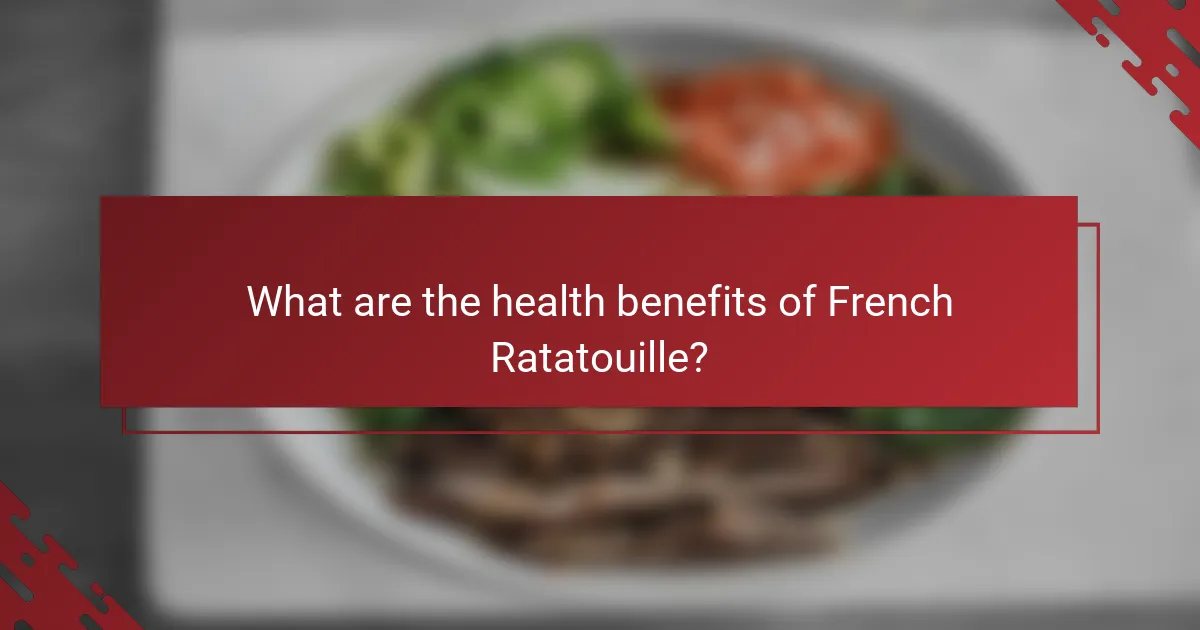
What are the health benefits of French Ratatouille?
French Ratatouille offers several health benefits. It is rich in vitamins and minerals due to its vegetable content. Key ingredients like tomatoes provide lycopene, which is linked to heart health. Eggplant contributes fiber, aiding digestion and promoting gut health. Bell peppers are high in vitamin C, supporting the immune system. Zucchini contains antioxidants, which help combat oxidative stress. The dish is low in calories, making it suitable for weight management. Additionally, the variety of vegetables can enhance overall nutrient intake.
How does Ratatouille contribute to a healthy diet?
Ratatouille contributes to a healthy diet by incorporating a variety of vegetables. It typically includes eggplant, zucchini, bell peppers, and tomatoes. These ingredients are rich in vitamins, minerals, and antioxidants. For example, tomatoes provide lycopene, which is beneficial for heart health. The dish is low in calories, making it suitable for weight management. Additionally, it is high in fiber, promoting digestive health. Ratatouille can be served as a main dish or a side, enhancing meal variety. Its plant-based nature aligns with dietary recommendations for increased vegetable intake.
What vitamins and minerals are found in Ratatouille’s ingredients?
Ratatouille contains various vitamins and minerals from its ingredients. Key vitamins include vitamin A, vitamin C, and several B vitamins. Vitamin A is present in vegetables like bell peppers and eggplant. Vitamin C is abundant in tomatoes and zucchini. B vitamins, such as B6 and folate, are found in ingredients like onions and garlic.
Minerals include potassium, magnesium, and iron. Potassium is high in tomatoes and eggplant. Magnesium can be sourced from zucchini and bell peppers. Iron is found in small amounts in various vegetables used in ratatouille. These vitamins and minerals contribute to the overall nutritional profile of the dish.
How can Ratatouille support weight management?
Ratatouille can support weight management by being low in calories and high in nutrients. It primarily consists of vegetables like zucchini, eggplant, and tomatoes. These vegetables are rich in fiber, which promotes satiety. Increased satiety can lead to reduced overall calorie intake. Ratatouille also contains healthy fats from olive oil, which can aid in nutrient absorption. Moreover, the dish is versatile and can be paired with lean proteins for balanced meals. Studies show that diets rich in vegetables are associated with lower body weight. Therefore, incorporating Ratatouille into a meal plan can assist in maintaining a healthy weight.
Why is Ratatouille considered a nutritious dish?
Ratatouille is considered a nutritious dish due to its rich array of vegetables. It typically includes tomatoes, zucchini, eggplant, bell peppers, and onions. These vegetables provide essential vitamins and minerals. For example, tomatoes are high in vitamin C and antioxidants. Zucchini is low in calories and high in fiber. Eggplant contains antioxidants like nasunin, which protects brain cells. Bell peppers are rich in vitamin A and potassium. The dish is also low in fat and calories, making it heart-healthy. Additionally, the preparation method, which often involves sautéing or baking, preserves nutrients. Overall, ratatouille is a balanced dish that supports a healthy diet.
What are the antioxidant properties of the vegetables used?
The vegetables used in French Ratatouille possess significant antioxidant properties. These vegetables include tomatoes, zucchini, eggplant, bell peppers, and onions. Tomatoes are rich in lycopene, a powerful antioxidant known for reducing the risk of chronic diseases. Zucchini contains vitamin C and beta-carotene, which help combat oxidative stress. Eggplant is high in nasunin, an antioxidant that protects brain cells. Bell peppers are loaded with vitamin C and various carotenoids, enhancing immune function. Onions provide quercetin, an antioxidant that may lower inflammation. Together, these vegetables contribute to a synergistic effect, boosting overall antioxidant capacity.
How does Ratatouille promote heart health?
Ratatouille promotes heart health through its use of vegetables rich in nutrients. The primary ingredients include tomatoes, zucchini, eggplant, and bell peppers. These vegetables are high in fiber and low in calories. Fiber contributes to lower cholesterol levels, which is beneficial for heart health. Additionally, tomatoes contain lycopene, an antioxidant linked to reduced heart disease risk. Olive oil, often used in ratatouille, is rich in monounsaturated fats. Monounsaturated fats can improve heart health by lowering bad cholesterol levels. Regular consumption of ratatouille may support overall cardiovascular health due to these beneficial components.
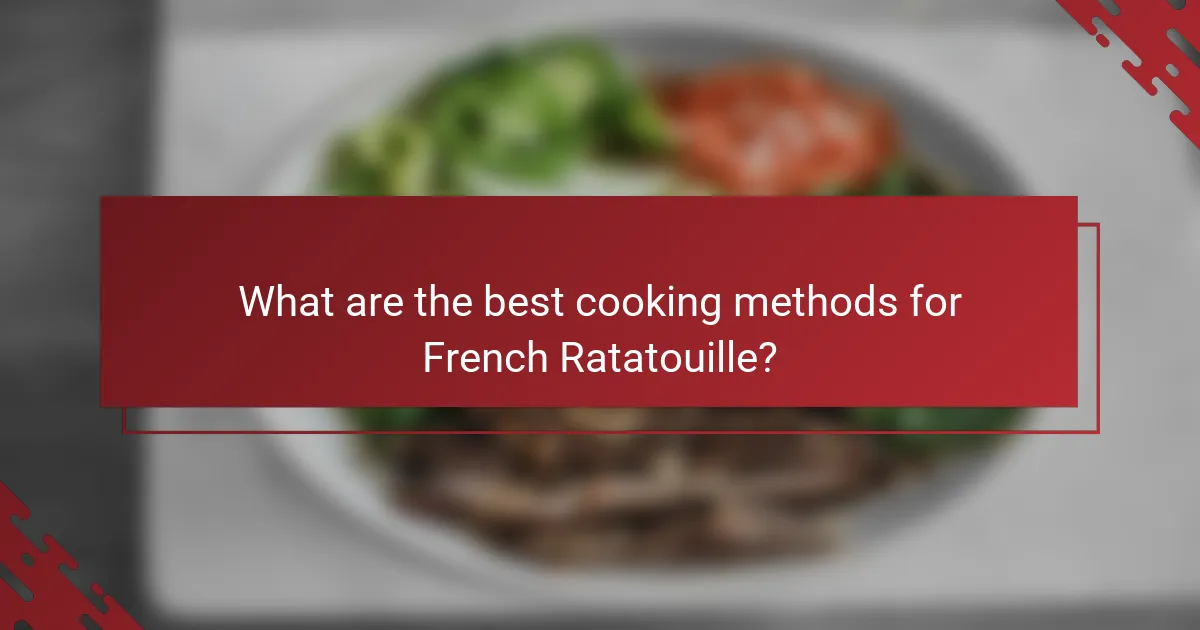
What are the best cooking methods for French Ratatouille?
The best cooking methods for French Ratatouille include sautéing, baking, and stewing. Sautéing involves cooking vegetables quickly in a small amount of oil over high heat. This method retains the vegetables’ flavors and textures. Baking allows the ingredients to meld together in the oven, enhancing the dish’s overall taste. Stewing involves simmering the vegetables slowly, which develops a rich flavor profile. Each of these methods can produce a delicious Ratatouille while highlighting the natural flavors of the vegetables used.
How can Ratatouille be prepared using different techniques?
Ratatouille can be prepared using various techniques such as sautéing, roasting, and layering. Sautéing involves cooking vegetables quickly in olive oil over high heat. This method retains the flavors and textures of the ingredients. Roasting allows the vegetables to caramelize, enhancing their natural sweetness. This technique requires spreading the chopped vegetables on a baking sheet and cooking them in the oven. Layering, often seen in the classic presentation, involves arranging sliced vegetables in a dish and baking them with herbs and sauce. Each technique highlights different aspects of the vegetables, contributing to the dish’s overall flavor and presentation.
What are the differences between sautéing and baking Ratatouille?
Sautéing and baking Ratatouille differ primarily in cooking technique and texture. Sautéing involves cooking ingredients quickly in a small amount of oil over high heat. This method retains the vegetables’ crispness and enhances their flavors through caramelization. Baking, on the other hand, uses dry heat in an oven, allowing the ingredients to cook slowly. This results in a softer texture and deeper flavor as the vegetables meld together. Sautéed Ratatouille typically has a vibrant appearance, while baked Ratatouille tends to be more uniform in color and softer in consistency.
How does simmering affect the flavor of Ratatouille?
Simmering enhances the flavor of Ratatouille by allowing the ingredients to meld together. The slow cooking process breaks down the vegetables, releasing their natural sugars. This results in a sweeter and more complex flavor profile. Additionally, simmering helps to soften the texture of the vegetables, making them more palatable. The prolonged heat also allows herbs and spices to infuse their essence into the dish. As a result, the overall taste becomes richer and more harmonious. Studies show that cooking methods like simmering can significantly improve flavor depth in vegetable dishes.
What are some tips for making the perfect Ratatouille?
Use fresh, seasonal vegetables for the best flavor in Ratatouille. Tomatoes, zucchini, eggplant, and bell peppers are essential. Slice the vegetables uniformly for even cooking. Sauté the onions and garlic first to build a flavor base. Layer the vegetables in a baking dish for an appealing presentation. Use herbs like thyme and basil to enhance the dish’s aroma. Cook slowly to allow the flavors to meld together. A splash of olive oil adds richness and depth. Aim for a tender texture without overcooking the vegetables.
How can ingredient selection enhance the dish’s flavor?
Ingredient selection enhances a dish’s flavor by providing distinct tastes and aromas. Each ingredient contributes unique flavor profiles. For example, fresh herbs like basil add brightness and complexity. Seasonal vegetables offer natural sweetness and texture. The quality of ingredients affects overall taste. High-quality tomatoes in ratatouille create a rich base. Combining complementary flavors, such as savory eggplant and sweet bell peppers, elevates the dish. Proper seasoning further enhances these flavors. Research shows that ingredient freshness correlates with flavor intensity, making selection crucial.
What common mistakes should be avoided when cooking Ratatouille?
Common mistakes to avoid when cooking Ratatouille include not using fresh vegetables. Fresh ingredients enhance flavor and texture. Overcooking the vegetables leads to mushiness and loss of taste. Each vegetable should retain its shape and integrity. Skipping the proper layering of ingredients can result in uneven cooking. Layering allows flavors to meld while maintaining distinct textures. Using too much oil can make the dish greasy. A moderate amount of oil enhances flavor without overwhelming the vegetables. Not seasoning adequately can lead to blandness. Proper seasoning enhances the overall taste profile of Ratatouille. Lastly, rushing the cooking process can diminish the dish’s depth of flavor. Slow cooking allows the ingredients to develop their full flavor potential.
French Ratatouille is a traditional Provençal vegetable dish known for its vibrant colors and rich flavors, primarily made from eggplant, zucchini, bell peppers, tomatoes, and onions. The article explores the origins of Ratatouille, tracing its roots back to 18th century France, and highlights its cultural influences from Mediterranean cuisine. It details the key ingredients, their health benefits, and various cooking methods, including sautéing, baking, and simmering, while emphasizing the importance of fresh, seasonal produce. Additionally, the article discusses how Ratatouille supports a healthy diet through its nutrient-rich composition and provides tips for preparing the dish effectively.
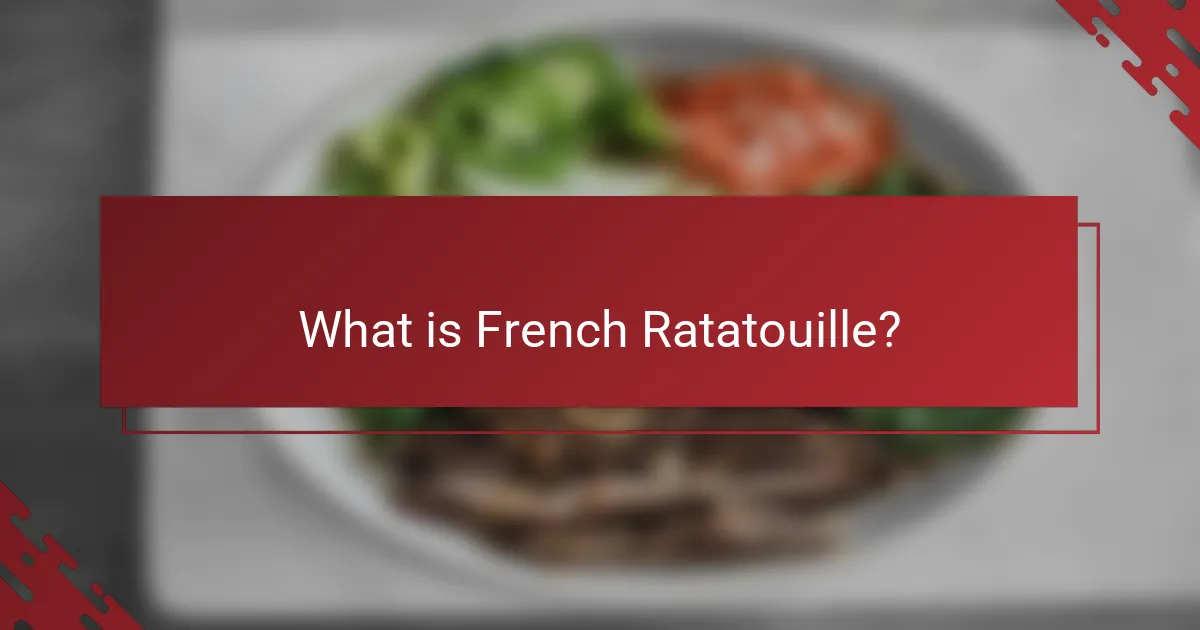
What is French Ratatouille?
French Ratatouille is a traditional Provençal vegetable dish. It typically includes ingredients like eggplant, zucchini, peppers, onions, and tomatoes. The vegetables are usually sautéed or stewed together. Ratatouille is known for its rich flavors and vibrant colors. This dish is often served as a side or a main course. It is also popular in Mediterranean cuisine. The origins of Ratatouille date back to the 18th century in Nice, France. It highlights the use of fresh, seasonal vegetables.
How did French Ratatouille originate?
French Ratatouille originated in the Provence region of France. It is a traditional vegetable dish that showcases seasonal produce. The dish typically includes ingredients like tomatoes, zucchini, eggplant, and bell peppers. Ratatouille has roots in rustic cooking, where farmers used available vegetables. The name “ratatouille” comes from the French verb “touiller,” meaning to stir. Historical references date back to the 18th century. The dish became popular as a way to utilize abundant summer vegetables. Ratatouille has evolved over time, with various regional adaptations.
What cultural influences shaped the recipe for Ratatouille?
The recipe for Ratatouille is shaped by Mediterranean and Provençal cultural influences. Originating in the region of Provence, Ratatouille reflects the agricultural practices and seasonal produce of southern France. The dish incorporates vegetables commonly found in Mediterranean cuisine, such as eggplant, zucchini, and bell peppers. These ingredients showcase the region’s emphasis on fresh, local produce. Ratatouille also embodies the rustic cooking style prevalent in Provençal households. The dish’s preparation methods highlight simplicity and the use of olive oil, a staple in Mediterranean cooking. Additionally, Ratatouille has been influenced by Italian ratatouille-like dishes, emphasizing the shared culinary heritage of the Mediterranean basin. This blend of influences contributes to Ratatouille’s status as a classic French dish.
How has Ratatouille evolved over time?
Ratatouille has evolved from a rustic peasant dish to a gourmet staple. Originally, it was a way for farmers to use surplus vegetables. Traditional ingredients included eggplant, zucchini, peppers, and tomatoes. Over time, chefs began refining the dish for fine dining. The modern version often features a more artistic presentation. Techniques such as sous-vide and layering have been introduced. Ratatouille is now celebrated for its vibrant colors and flavors. It has also inspired various adaptations in international cuisines.
What are the key ingredients of French Ratatouille?
The key ingredients of French Ratatouille include eggplant, zucchini, bell peppers, tomatoes, onions, and garlic. Eggplant adds a unique texture and absorbs flavors well. Zucchini provides a mild taste and complements other vegetables. Bell peppers contribute sweetness and vibrant color to the dish. Tomatoes serve as a base, adding acidity and moisture. Onions enhance the overall flavor profile with their sweetness. Garlic adds depth and aromatic qualities. These ingredients are typically sautéed or stewed together, creating a harmonious blend of flavors.
Which vegetables are essential for a traditional Ratatouille?
The essential vegetables for a traditional Ratatouille are eggplant, zucchini, bell peppers, tomatoes, and onions. Eggplant provides a unique texture and absorbs flavors well. Zucchini adds moisture and a mild taste. Bell peppers contribute sweetness and color to the dish. Tomatoes are crucial for the sauce base, providing acidity and richness. Onions add depth and sweetness to the overall flavor profile. These vegetables are commonly used in classic Ratatouille recipes, ensuring authenticity and traditional taste.
What role do herbs and spices play in Ratatouille?
Herbs and spices are essential for flavoring Ratatouille. They enhance the dish’s aromatic profile and complexity. Common herbs used include thyme, basil, and parsley. These herbs contribute freshness and depth to the vegetable medley. Spices like black pepper add subtle heat. The combination of these elements creates a harmonious balance of flavors. Herbs and spices elevate Ratatouille from a simple vegetable dish to a gourmet experience. Their inclusion is rooted in traditional French cooking practices, emphasizing the importance of fresh ingredients.
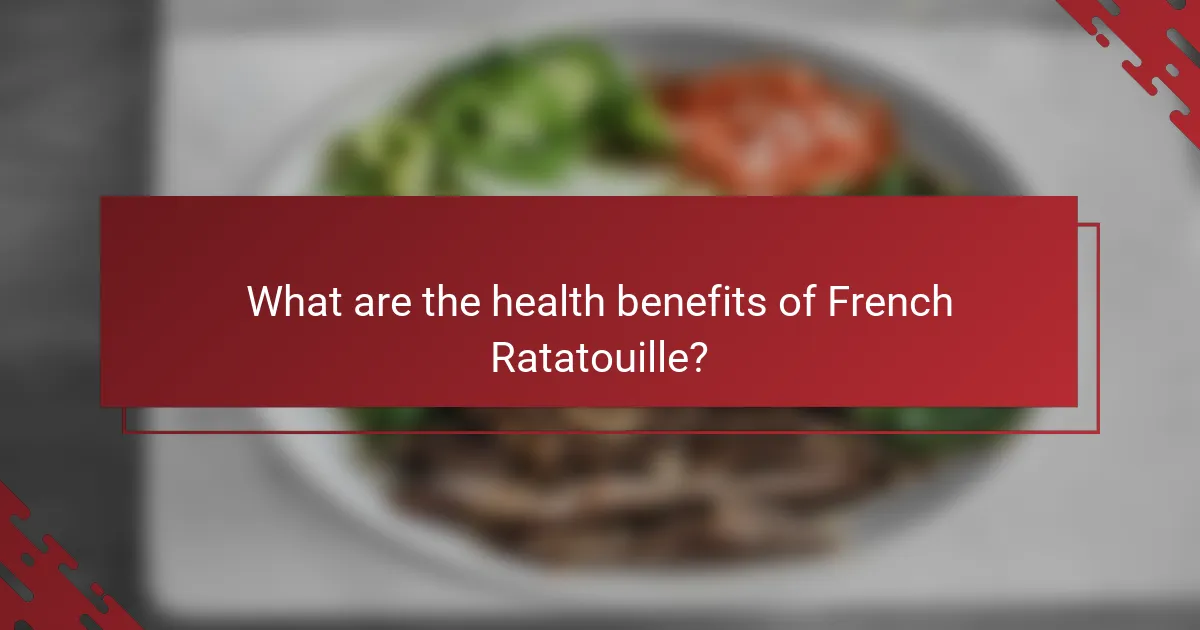
What are the health benefits of French Ratatouille?
French Ratatouille offers several health benefits. It is rich in vitamins and minerals due to its vegetable content. Key ingredients like tomatoes provide lycopene, which is linked to heart health. Eggplant contributes fiber, aiding digestion and promoting gut health. Bell peppers are high in vitamin C, supporting the immune system. Zucchini contains antioxidants, which help combat oxidative stress. The dish is low in calories, making it suitable for weight management. Additionally, the variety of vegetables can enhance overall nutrient intake.
How does Ratatouille contribute to a healthy diet?
Ratatouille contributes to a healthy diet by incorporating a variety of vegetables. It typically includes eggplant, zucchini, bell peppers, and tomatoes. These ingredients are rich in vitamins, minerals, and antioxidants. For example, tomatoes provide lycopene, which is beneficial for heart health. The dish is low in calories, making it suitable for weight management. Additionally, it is high in fiber, promoting digestive health. Ratatouille can be served as a main dish or a side, enhancing meal variety. Its plant-based nature aligns with dietary recommendations for increased vegetable intake.
What vitamins and minerals are found in Ratatouille’s ingredients?
Ratatouille contains various vitamins and minerals from its ingredients. Key vitamins include vitamin A, vitamin C, and several B vitamins. Vitamin A is present in vegetables like bell peppers and eggplant. Vitamin C is abundant in tomatoes and zucchini. B vitamins, such as B6 and folate, are found in ingredients like onions and garlic.
Minerals include potassium, magnesium, and iron. Potassium is high in tomatoes and eggplant. Magnesium can be sourced from zucchini and bell peppers. Iron is found in small amounts in various vegetables used in ratatouille. These vitamins and minerals contribute to the overall nutritional profile of the dish.
How can Ratatouille support weight management?
Ratatouille can support weight management by being low in calories and high in nutrients. It primarily consists of vegetables like zucchini, eggplant, and tomatoes. These vegetables are rich in fiber, which promotes satiety. Increased satiety can lead to reduced overall calorie intake. Ratatouille also contains healthy fats from olive oil, which can aid in nutrient absorption. Moreover, the dish is versatile and can be paired with lean proteins for balanced meals. Studies show that diets rich in vegetables are associated with lower body weight. Therefore, incorporating Ratatouille into a meal plan can assist in maintaining a healthy weight.
Why is Ratatouille considered a nutritious dish?
Ratatouille is considered a nutritious dish due to its rich array of vegetables. It typically includes tomatoes, zucchini, eggplant, bell peppers, and onions. These vegetables provide essential vitamins and minerals. For example, tomatoes are high in vitamin C and antioxidants. Zucchini is low in calories and high in fiber. Eggplant contains antioxidants like nasunin, which protects brain cells. Bell peppers are rich in vitamin A and potassium. The dish is also low in fat and calories, making it heart-healthy. Additionally, the preparation method, which often involves sautéing or baking, preserves nutrients. Overall, ratatouille is a balanced dish that supports a healthy diet.
What are the antioxidant properties of the vegetables used?
The vegetables used in French Ratatouille possess significant antioxidant properties. These vegetables include tomatoes, zucchini, eggplant, bell peppers, and onions. Tomatoes are rich in lycopene, a powerful antioxidant known for reducing the risk of chronic diseases. Zucchini contains vitamin C and beta-carotene, which help combat oxidative stress. Eggplant is high in nasunin, an antioxidant that protects brain cells. Bell peppers are loaded with vitamin C and various carotenoids, enhancing immune function. Onions provide quercetin, an antioxidant that may lower inflammation. Together, these vegetables contribute to a synergistic effect, boosting overall antioxidant capacity.
How does Ratatouille promote heart health?
Ratatouille promotes heart health through its use of vegetables rich in nutrients. The primary ingredients include tomatoes, zucchini, eggplant, and bell peppers. These vegetables are high in fiber and low in calories. Fiber contributes to lower cholesterol levels, which is beneficial for heart health. Additionally, tomatoes contain lycopene, an antioxidant linked to reduced heart disease risk. Olive oil, often used in ratatouille, is rich in monounsaturated fats. Monounsaturated fats can improve heart health by lowering bad cholesterol levels. Regular consumption of ratatouille may support overall cardiovascular health due to these beneficial components.
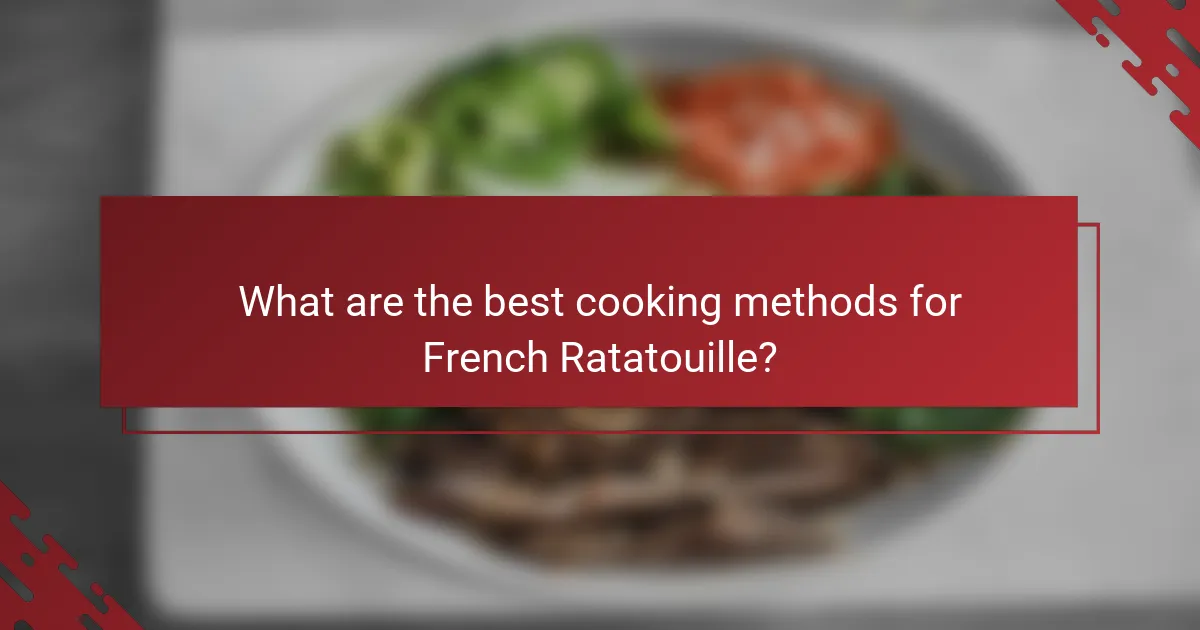
What are the best cooking methods for French Ratatouille?
The best cooking methods for French Ratatouille include sautéing, baking, and stewing. Sautéing involves cooking vegetables quickly in a small amount of oil over high heat. This method retains the vegetables’ flavors and textures. Baking allows the ingredients to meld together in the oven, enhancing the dish’s overall taste. Stewing involves simmering the vegetables slowly, which develops a rich flavor profile. Each of these methods can produce a delicious Ratatouille while highlighting the natural flavors of the vegetables used.
How can Ratatouille be prepared using different techniques?
Ratatouille can be prepared using various techniques such as sautéing, roasting, and layering. Sautéing involves cooking vegetables quickly in olive oil over high heat. This method retains the flavors and textures of the ingredients. Roasting allows the vegetables to caramelize, enhancing their natural sweetness. This technique requires spreading the chopped vegetables on a baking sheet and cooking them in the oven. Layering, often seen in the classic presentation, involves arranging sliced vegetables in a dish and baking them with herbs and sauce. Each technique highlights different aspects of the vegetables, contributing to the dish’s overall flavor and presentation.
What are the differences between sautéing and baking Ratatouille?
Sautéing and baking Ratatouille differ primarily in cooking technique and texture. Sautéing involves cooking ingredients quickly in a small amount of oil over high heat. This method retains the vegetables’ crispness and enhances their flavors through caramelization. Baking, on the other hand, uses dry heat in an oven, allowing the ingredients to cook slowly. This results in a softer texture and deeper flavor as the vegetables meld together. Sautéed Ratatouille typically has a vibrant appearance, while baked Ratatouille tends to be more uniform in color and softer in consistency.
How does simmering affect the flavor of Ratatouille?
Simmering enhances the flavor of Ratatouille by allowing the ingredients to meld together. The slow cooking process breaks down the vegetables, releasing their natural sugars. This results in a sweeter and more complex flavor profile. Additionally, simmering helps to soften the texture of the vegetables, making them more palatable. The prolonged heat also allows herbs and spices to infuse their essence into the dish. As a result, the overall taste becomes richer and more harmonious. Studies show that cooking methods like simmering can significantly improve flavor depth in vegetable dishes.
What are some tips for making the perfect Ratatouille?
Use fresh, seasonal vegetables for the best flavor in Ratatouille. Tomatoes, zucchini, eggplant, and bell peppers are essential. Slice the vegetables uniformly for even cooking. Sauté the onions and garlic first to build a flavor base. Layer the vegetables in a baking dish for an appealing presentation. Use herbs like thyme and basil to enhance the dish’s aroma. Cook slowly to allow the flavors to meld together. A splash of olive oil adds richness and depth. Aim for a tender texture without overcooking the vegetables.
How can ingredient selection enhance the dish’s flavor?
Ingredient selection enhances a dish’s flavor by providing distinct tastes and aromas. Each ingredient contributes unique flavor profiles. For example, fresh herbs like basil add brightness and complexity. Seasonal vegetables offer natural sweetness and texture. The quality of ingredients affects overall taste. High-quality tomatoes in ratatouille create a rich base. Combining complementary flavors, such as savory eggplant and sweet bell peppers, elevates the dish. Proper seasoning further enhances these flavors. Research shows that ingredient freshness correlates with flavor intensity, making selection crucial.
What common mistakes should be avoided when cooking Ratatouille?
Common mistakes to avoid when cooking Ratatouille include not using fresh vegetables. Fresh ingredients enhance flavor and texture. Overcooking the vegetables leads to mushiness and loss of taste. Each vegetable should retain its shape and integrity. Skipping the proper layering of ingredients can result in uneven cooking. Layering allows flavors to meld while maintaining distinct textures. Using too much oil can make the dish greasy. A moderate amount of oil enhances flavor without overwhelming the vegetables. Not seasoning adequately can lead to blandness. Proper seasoning enhances the overall taste profile of Ratatouille. Lastly, rushing the cooking process can diminish the dish’s depth of flavor. Slow cooking allows the ingredients to develop their full flavor potential.